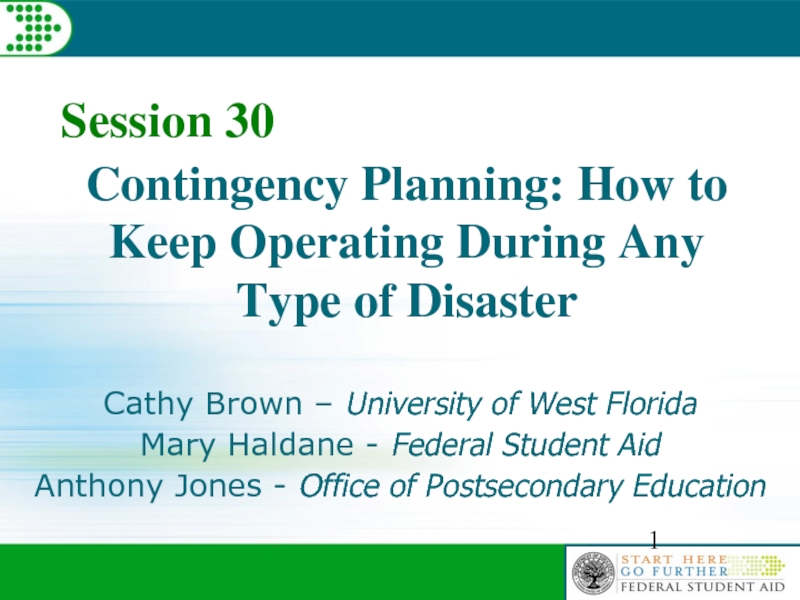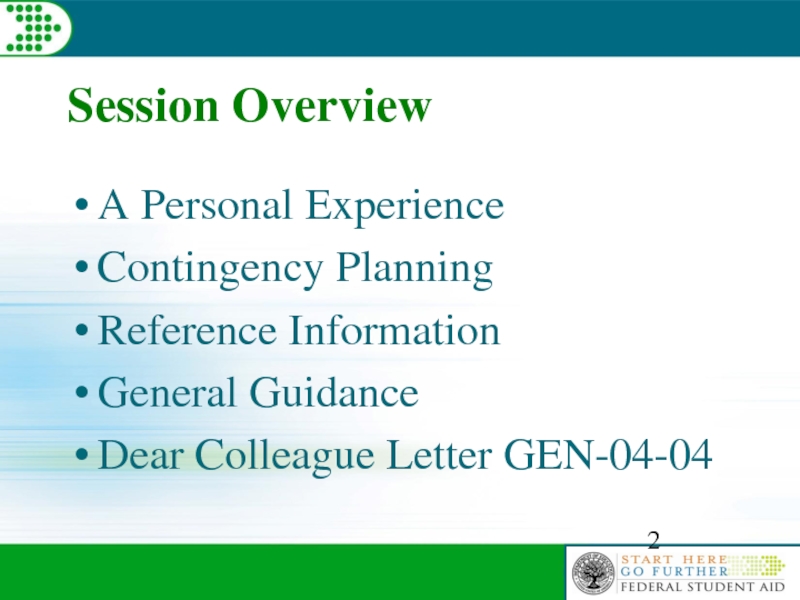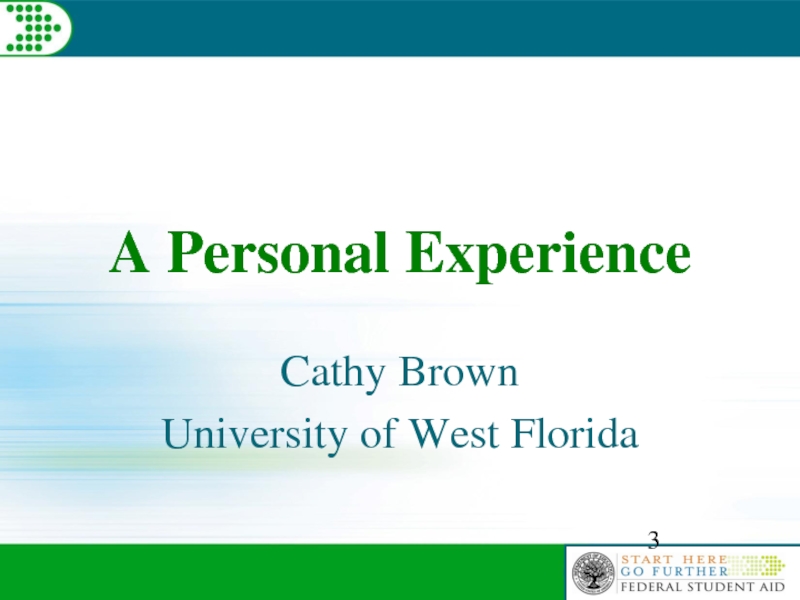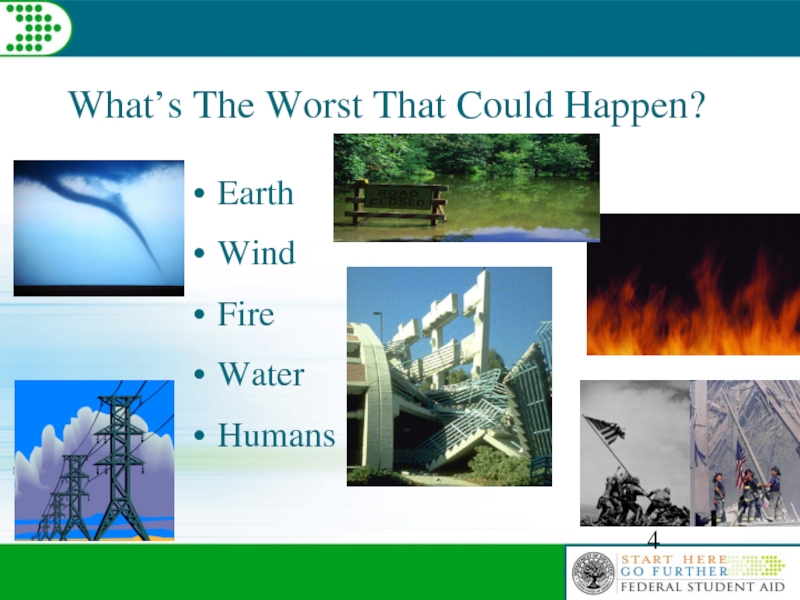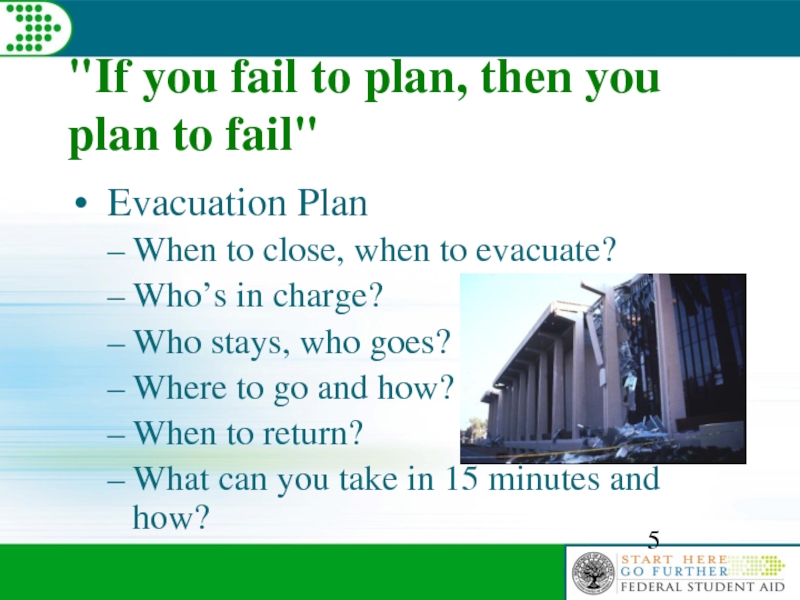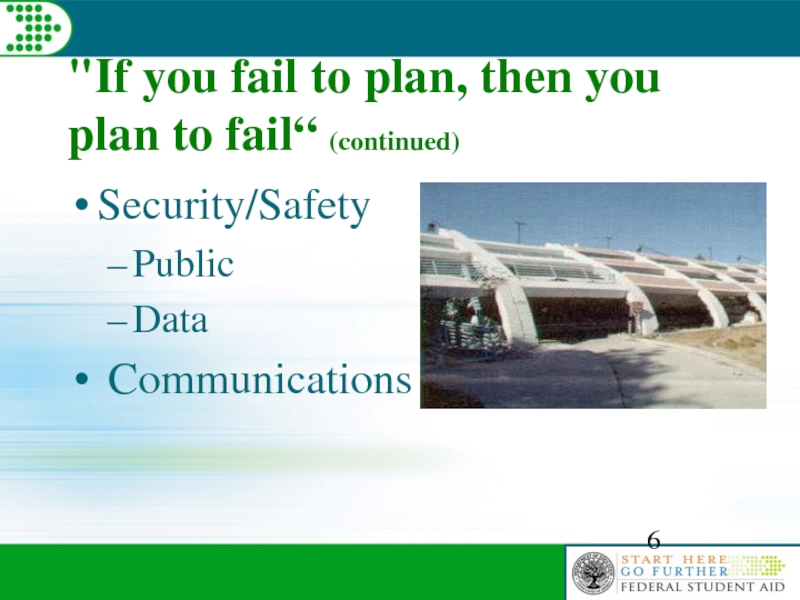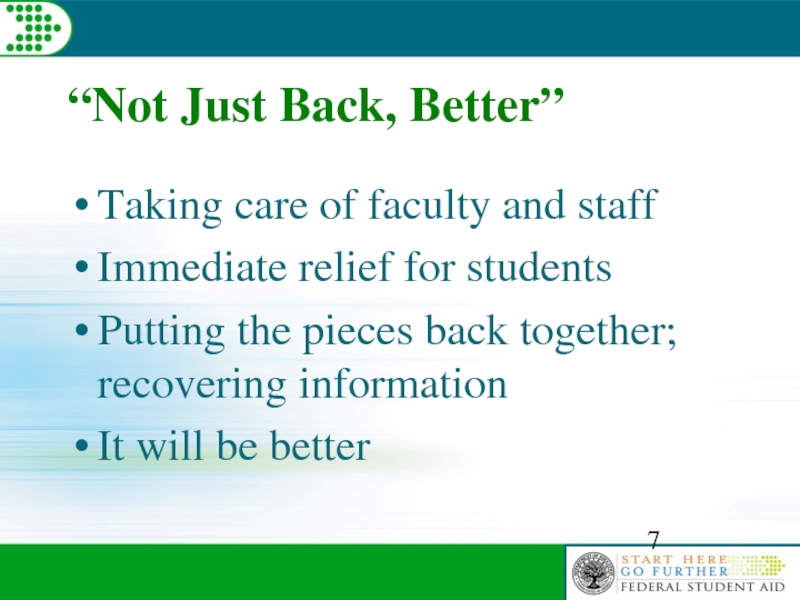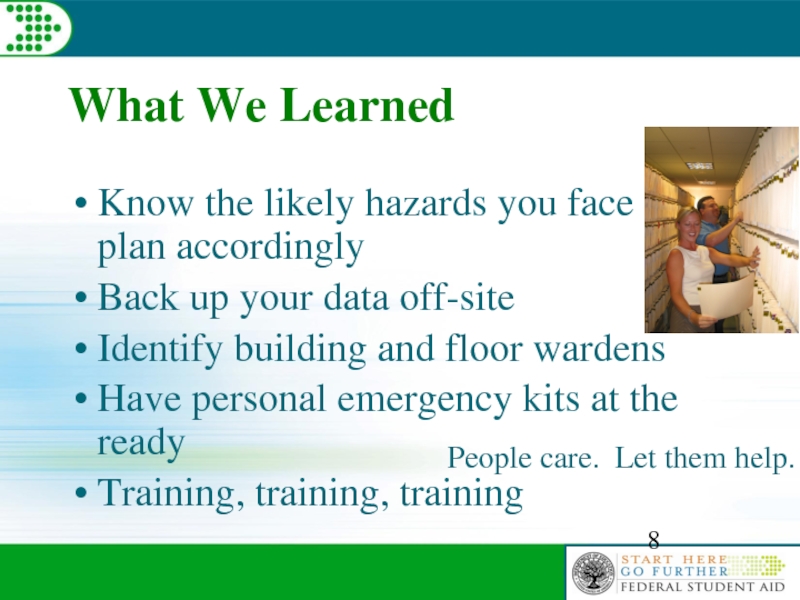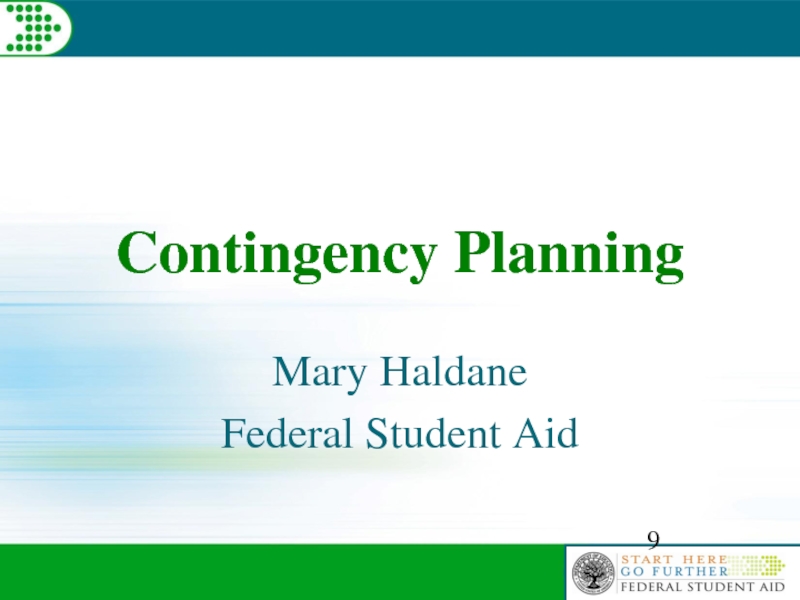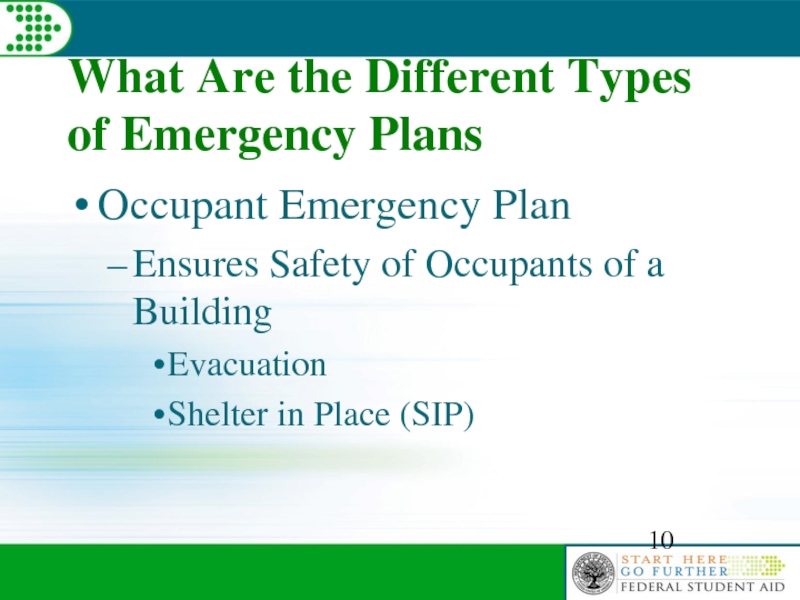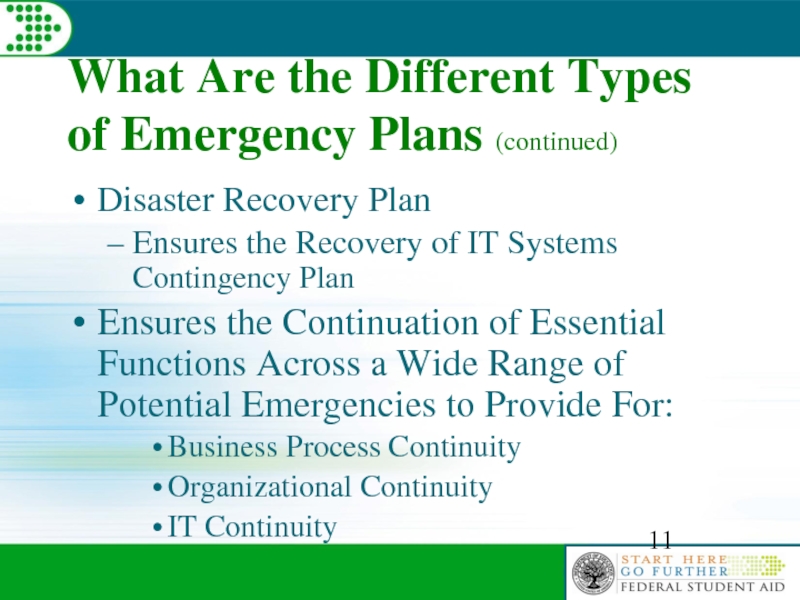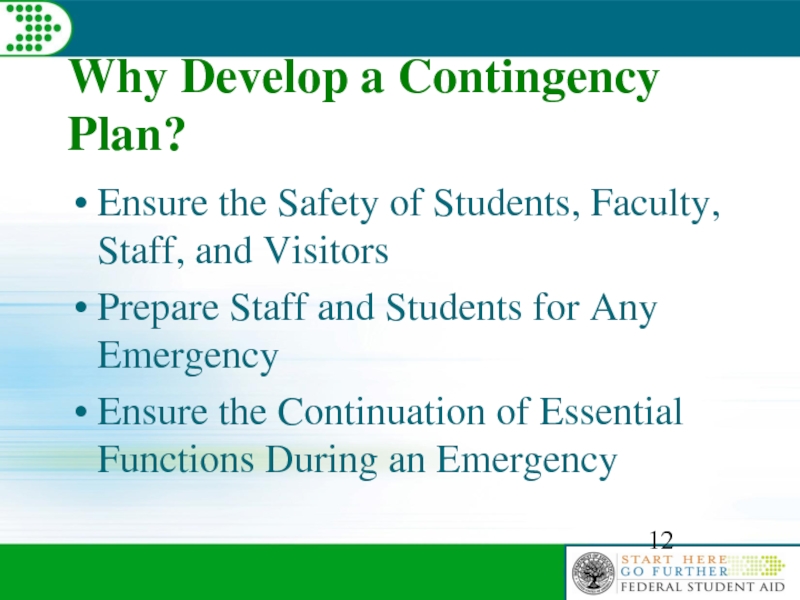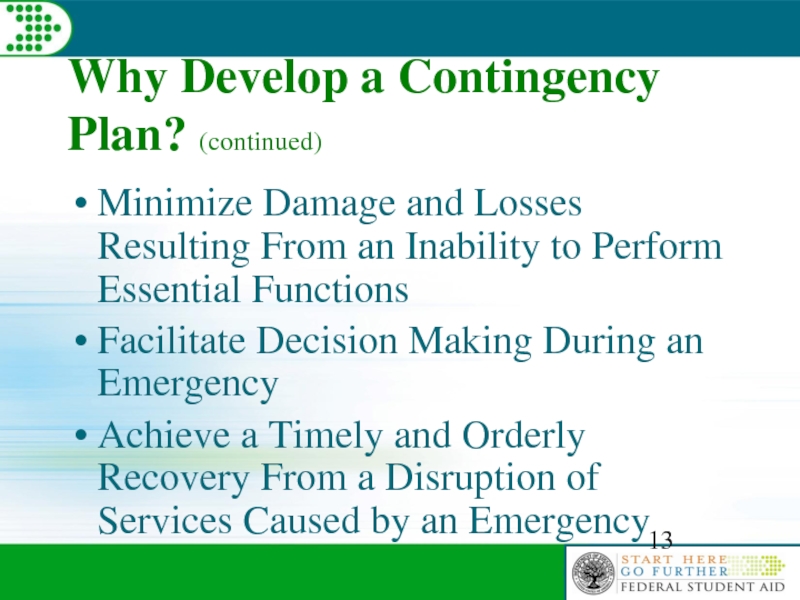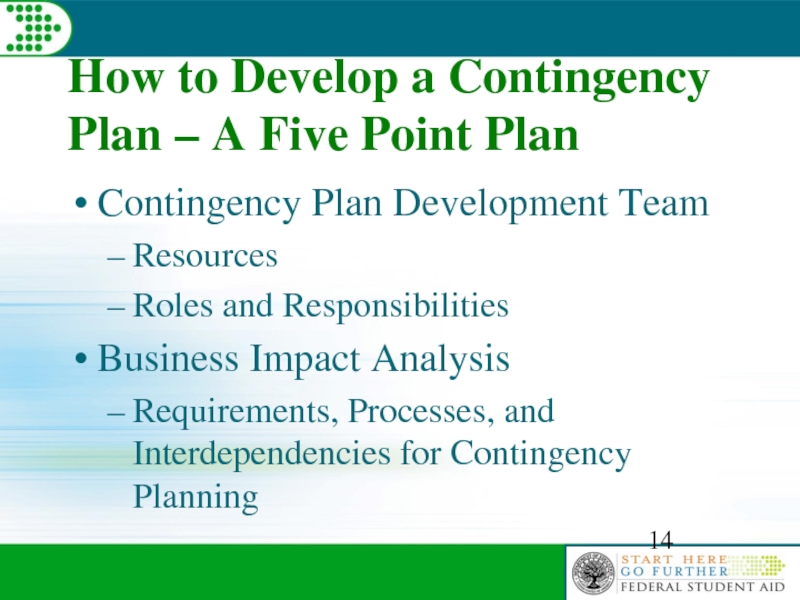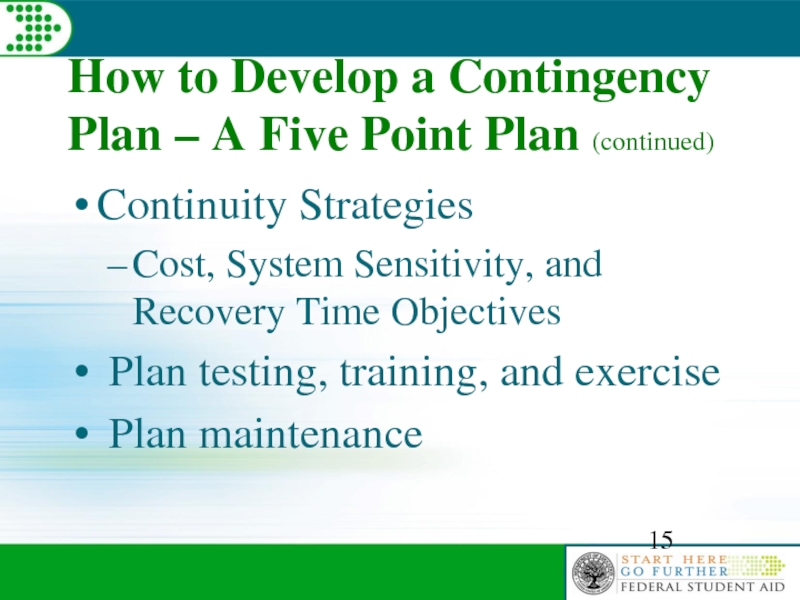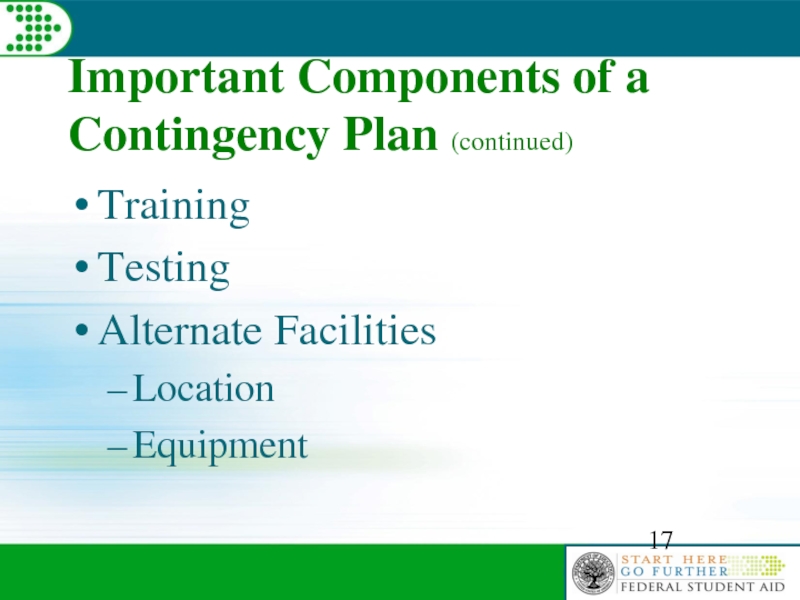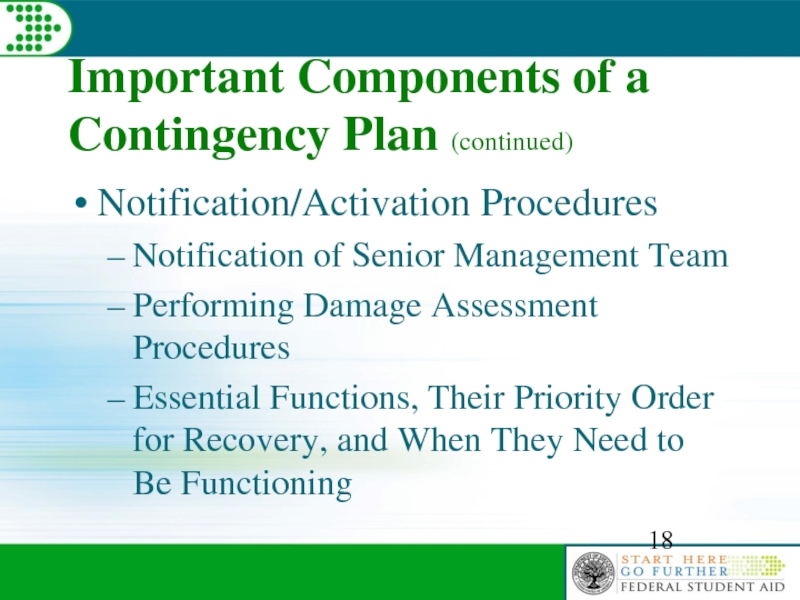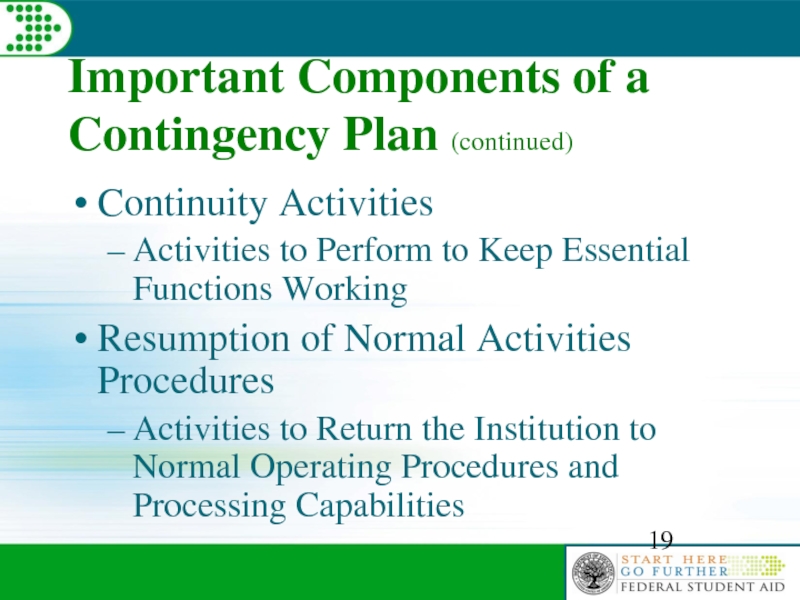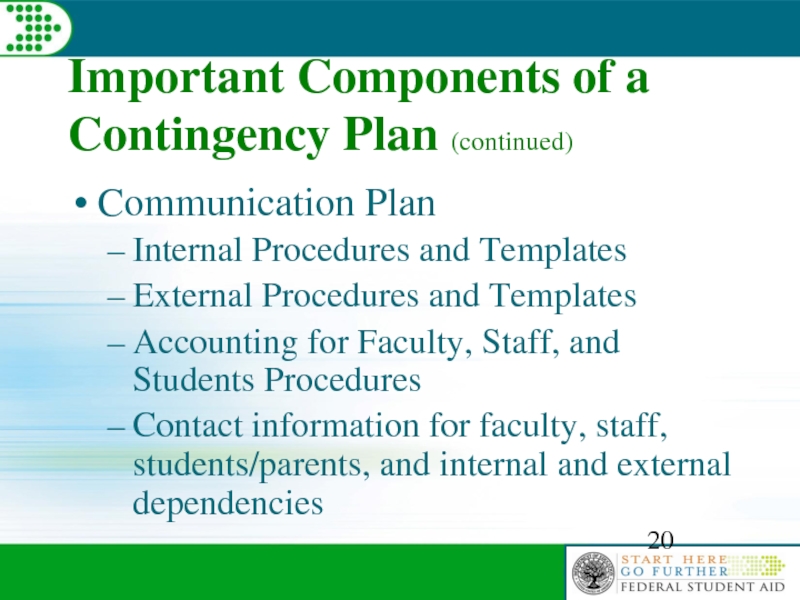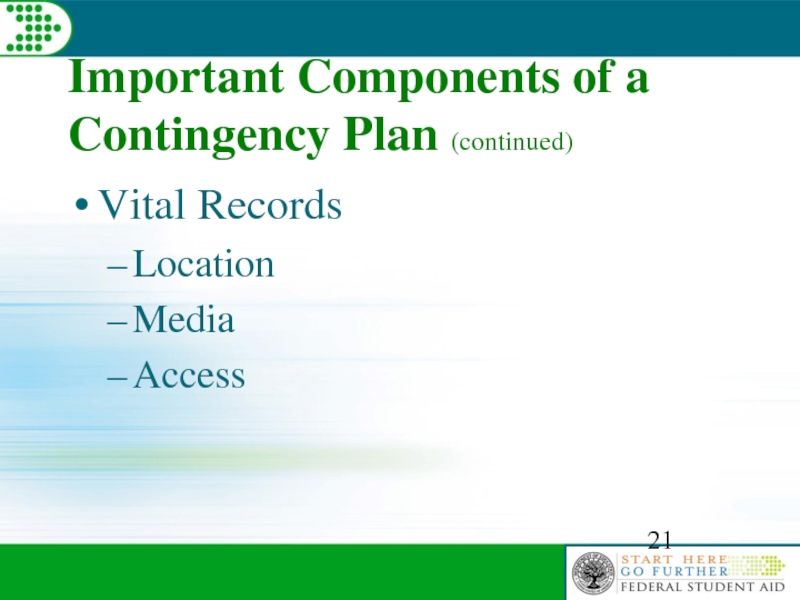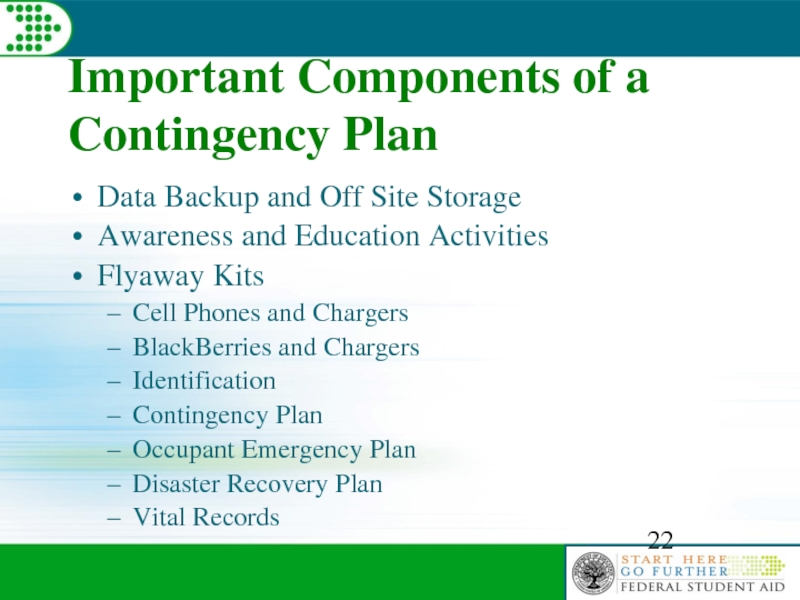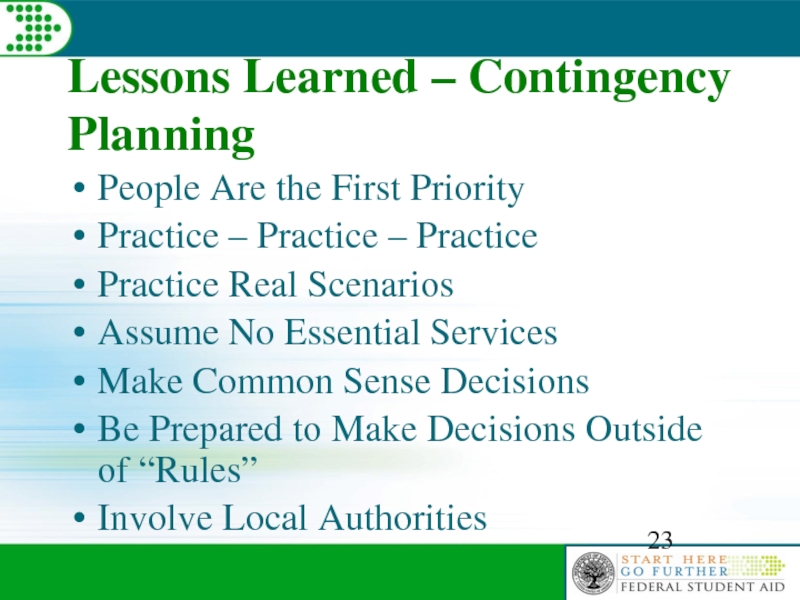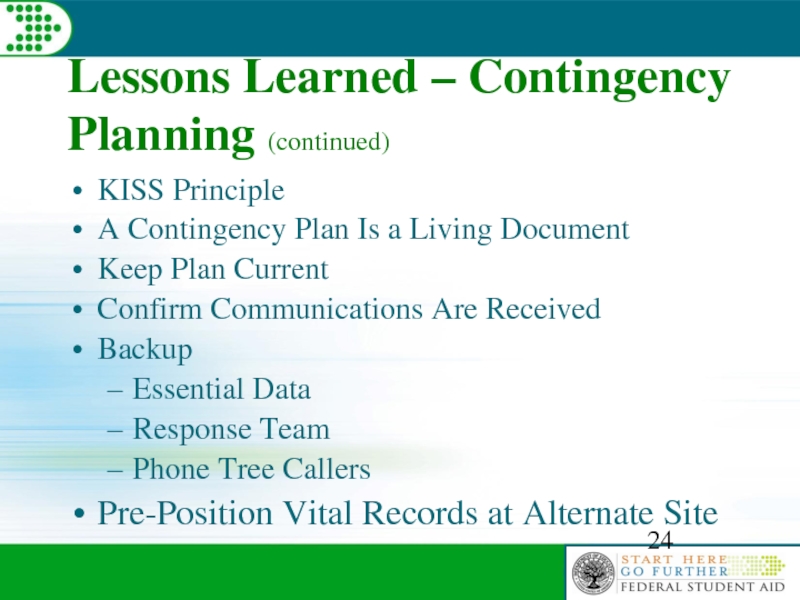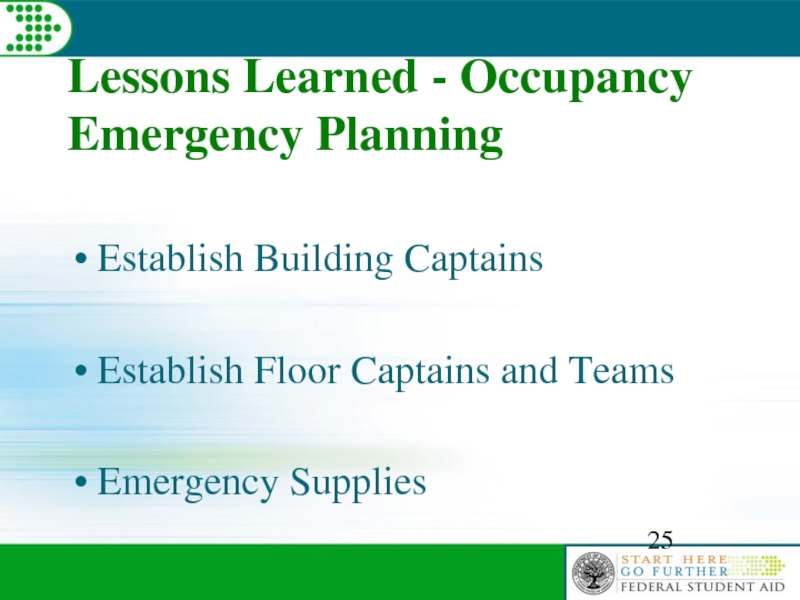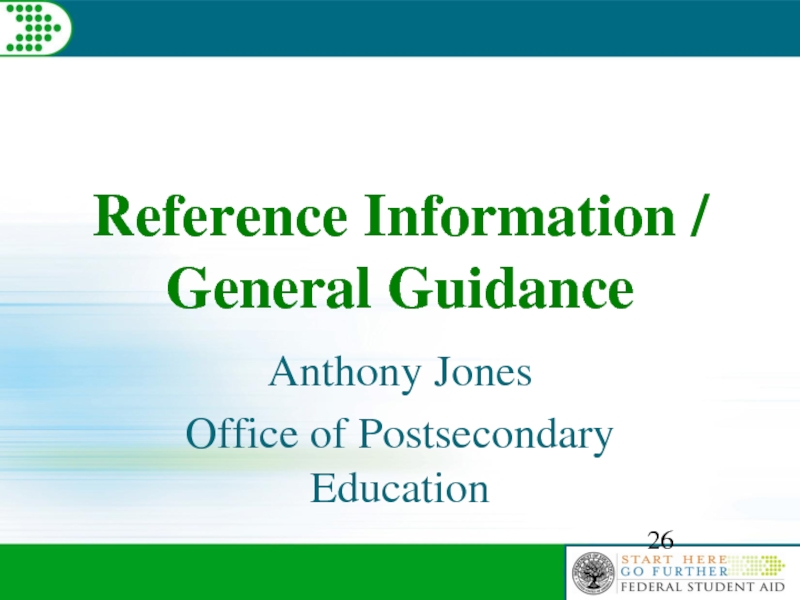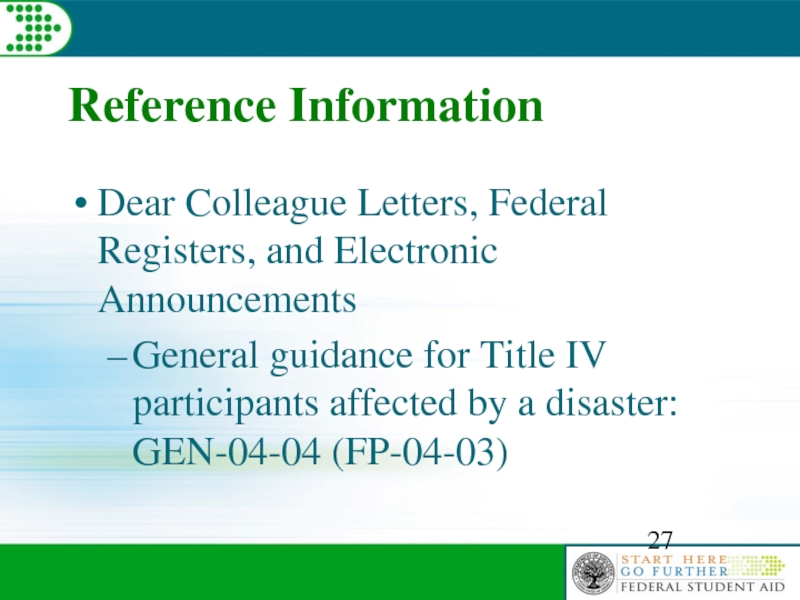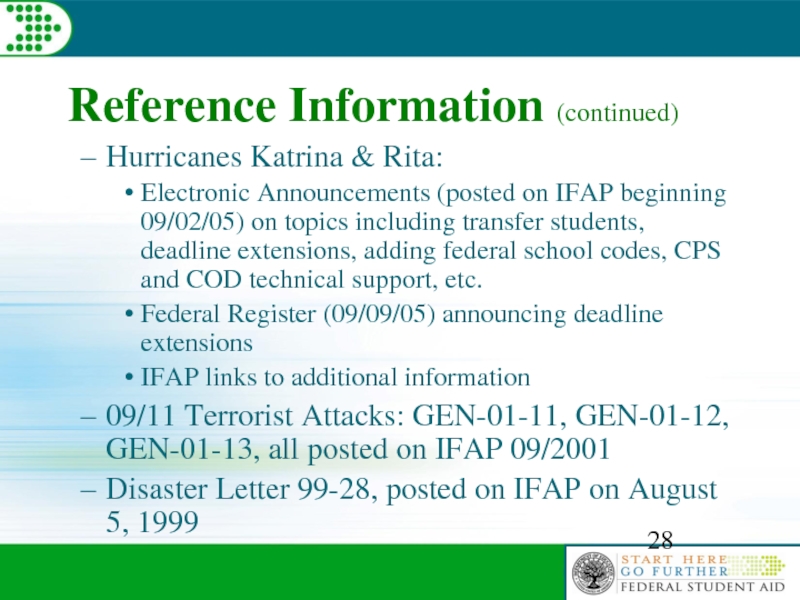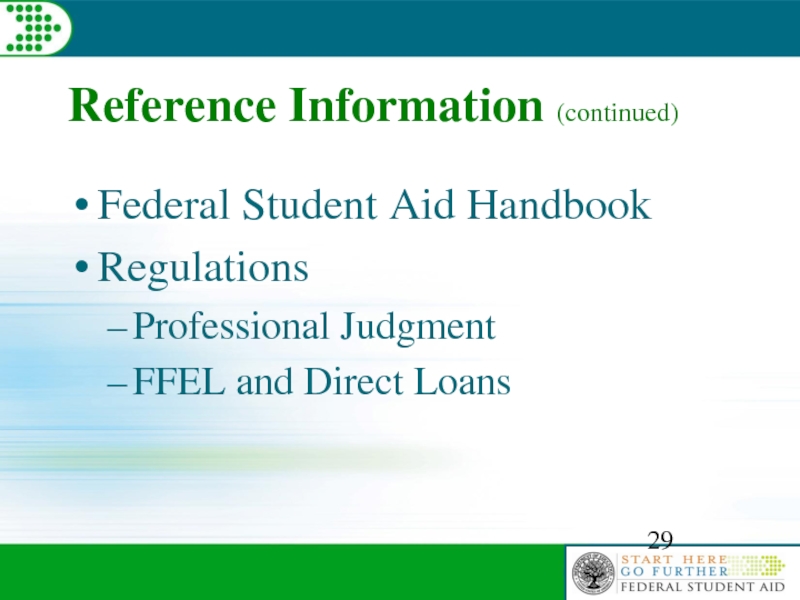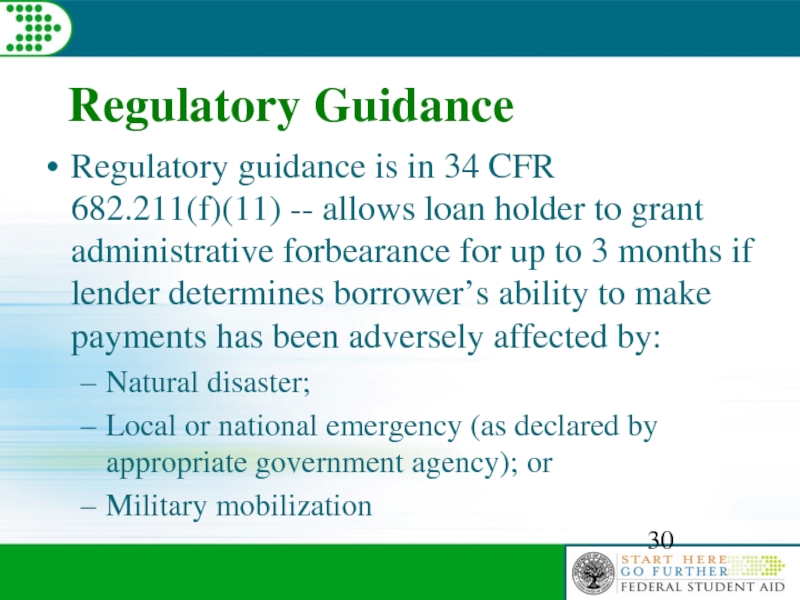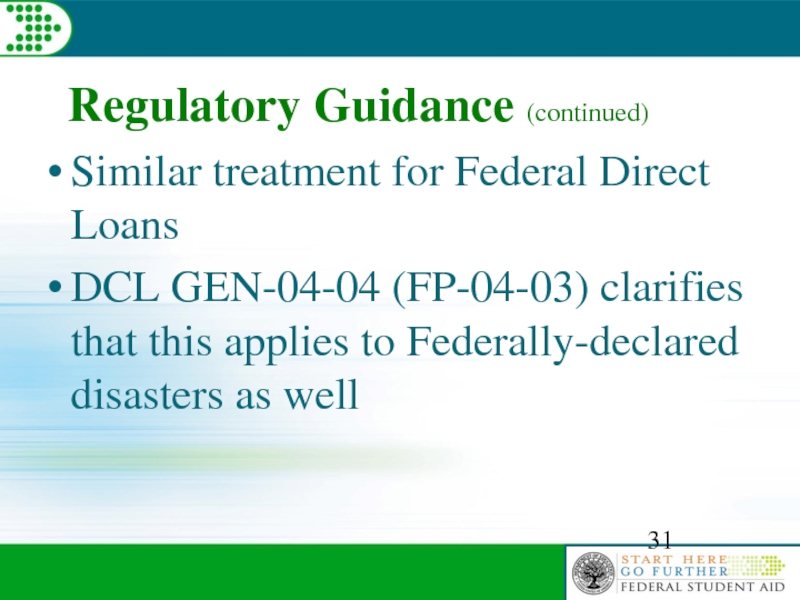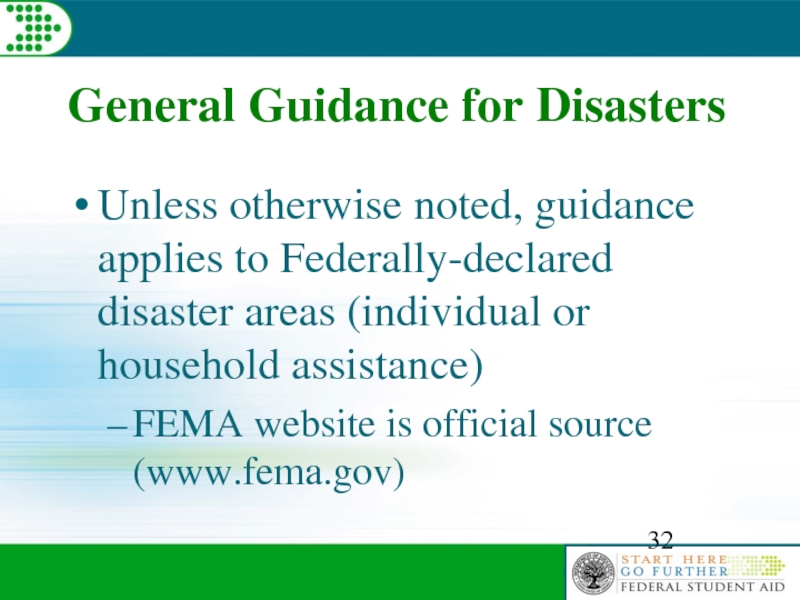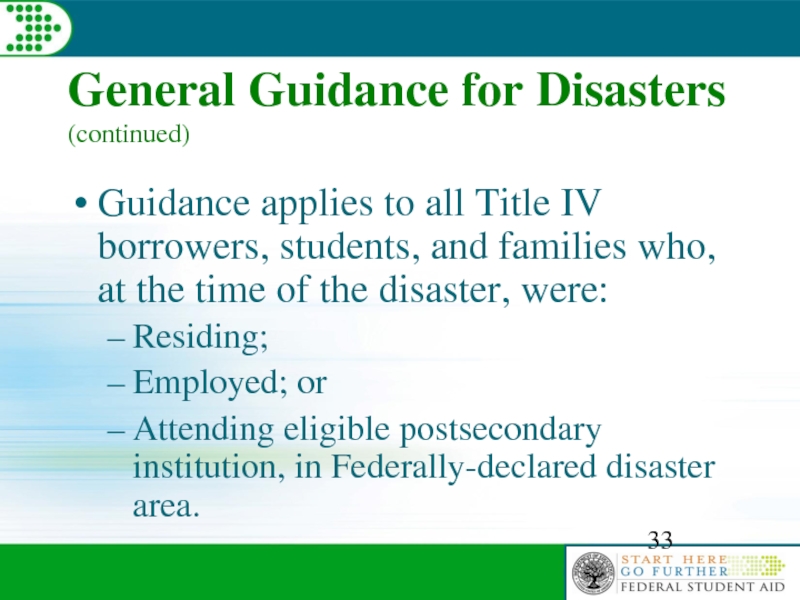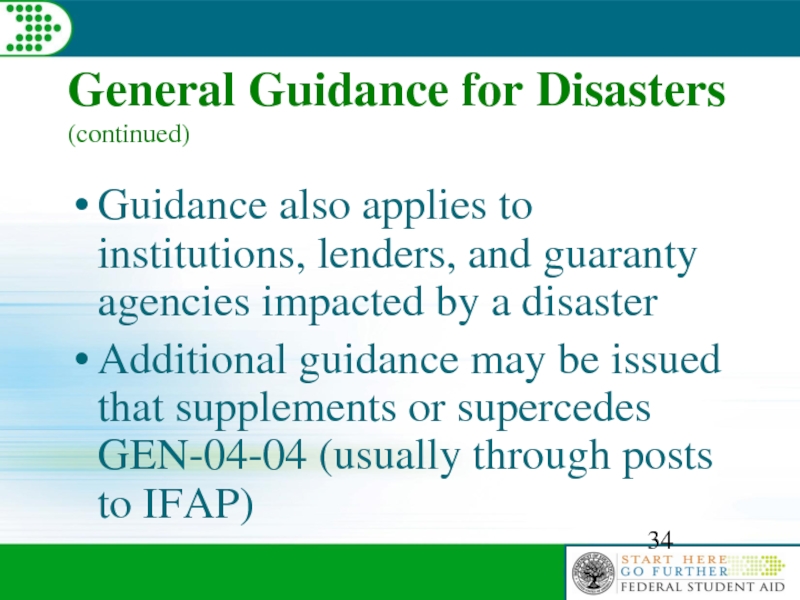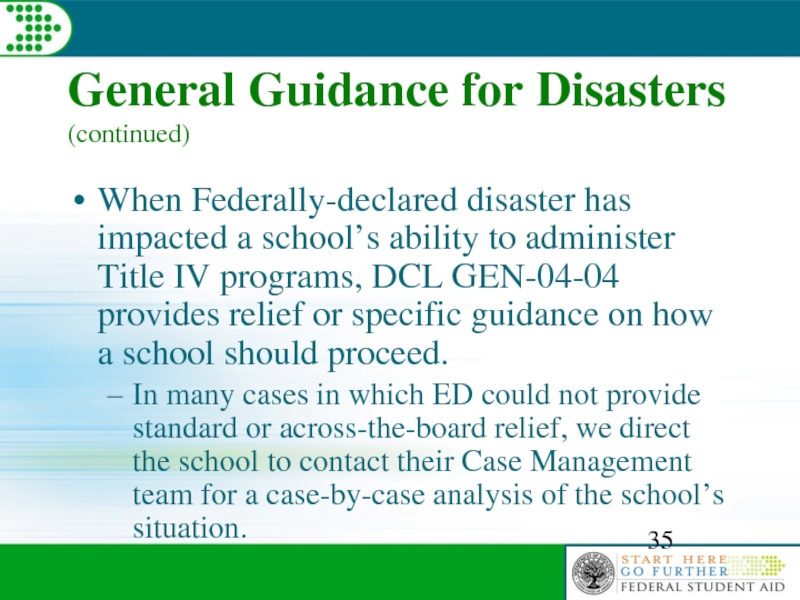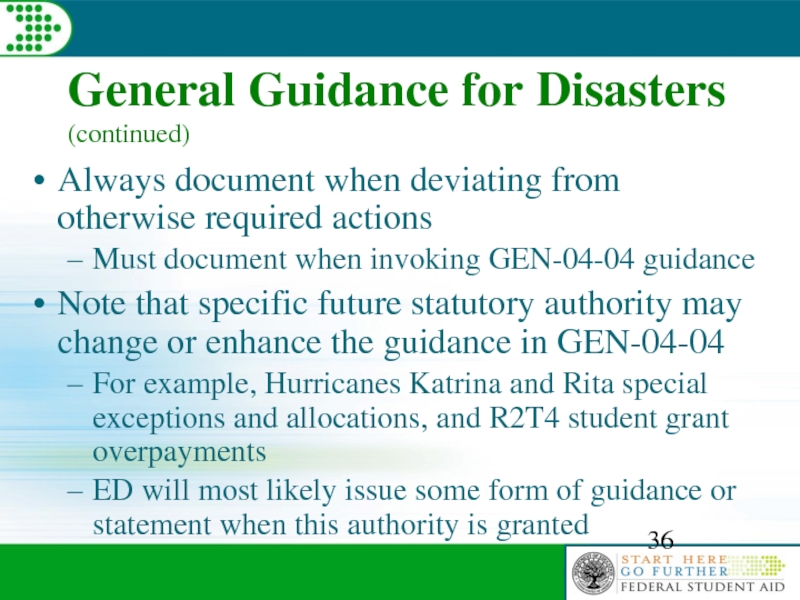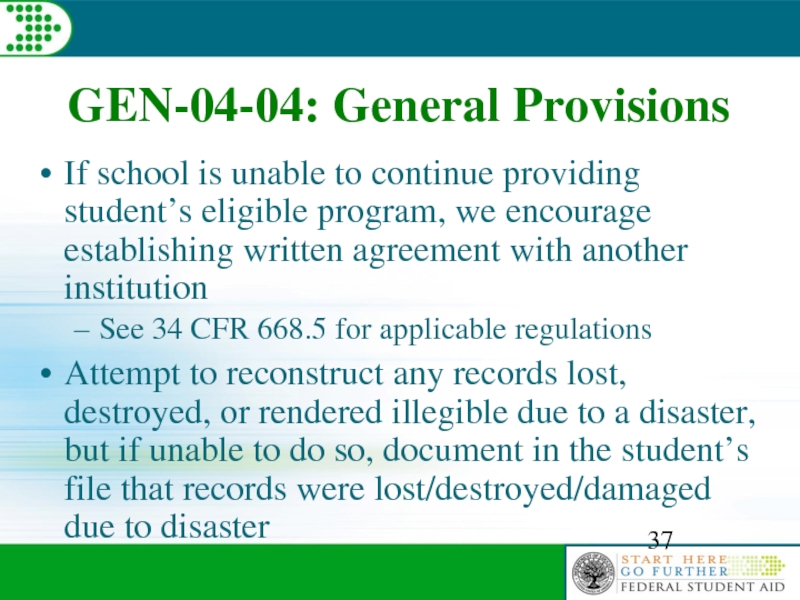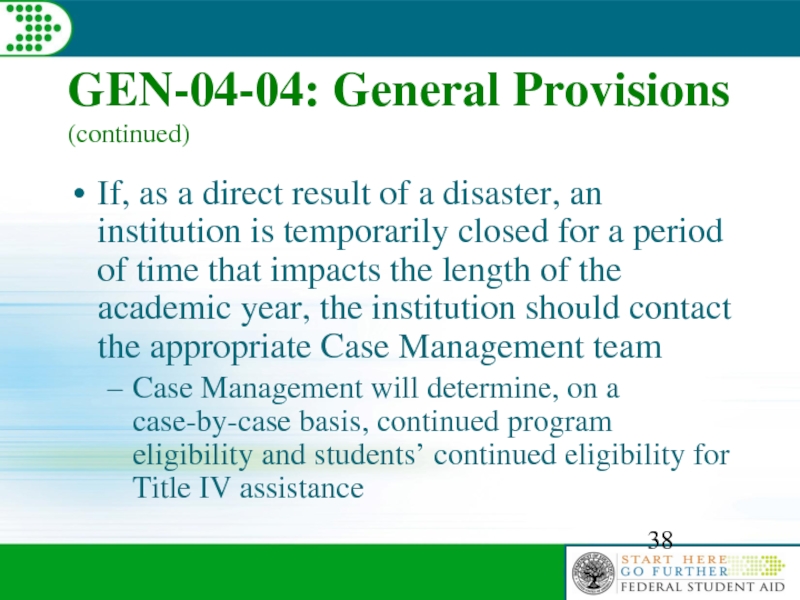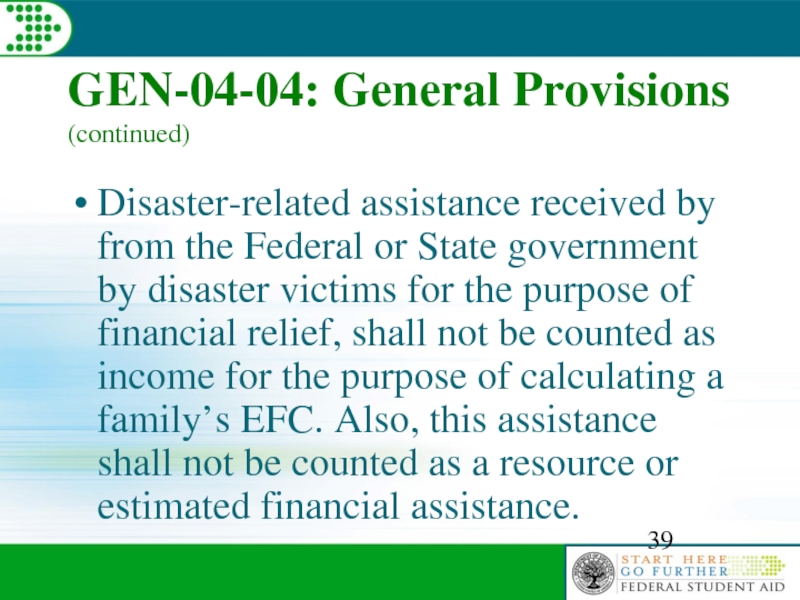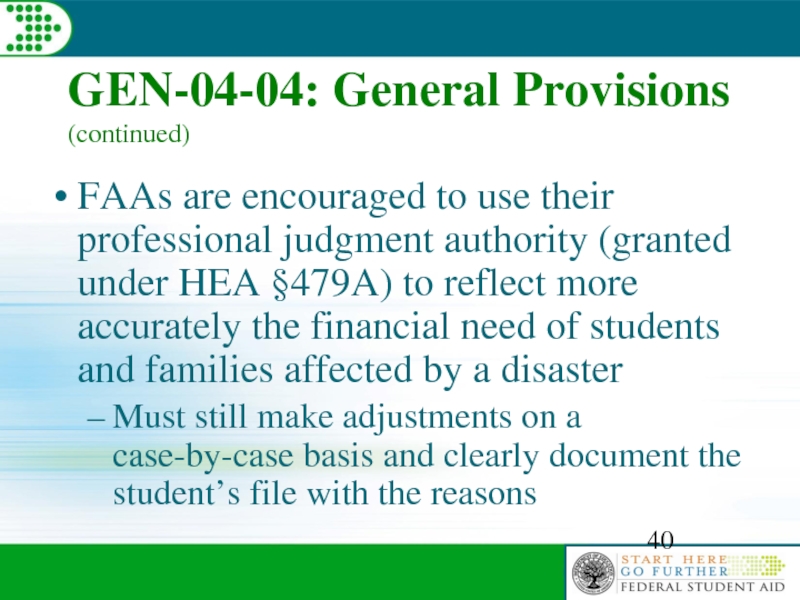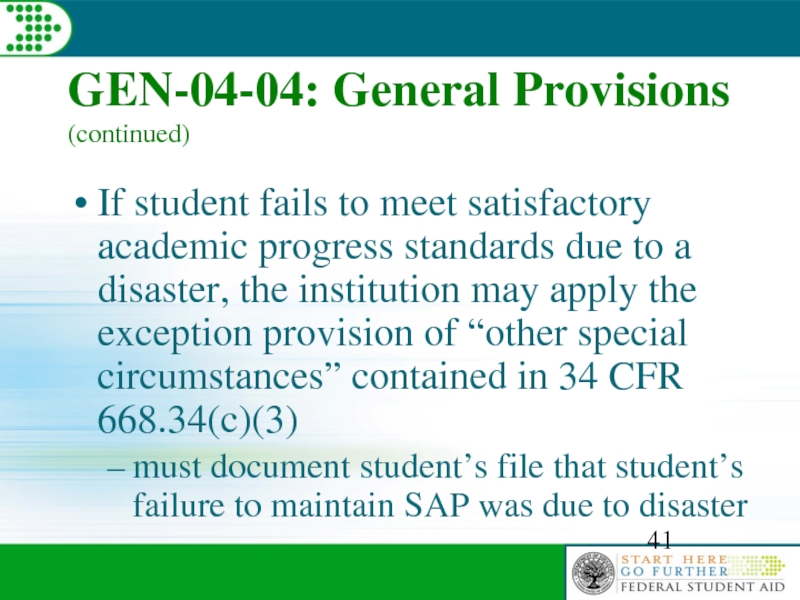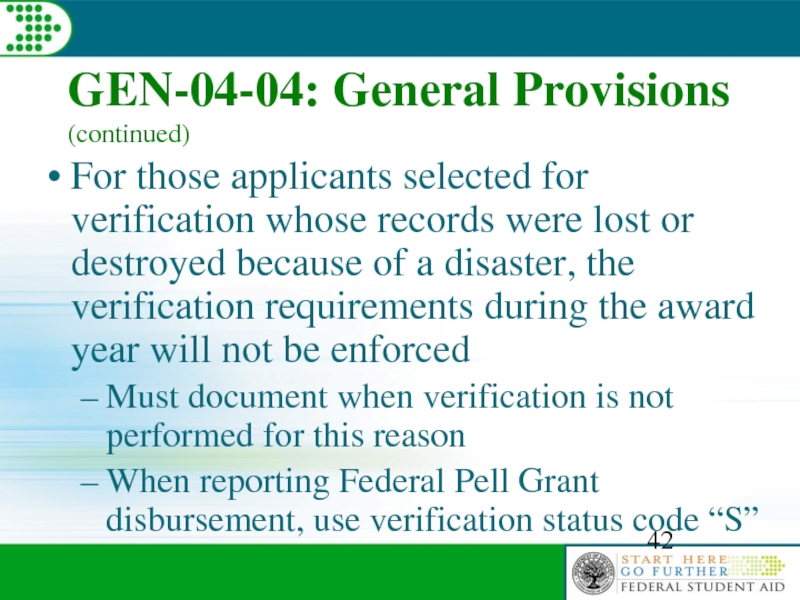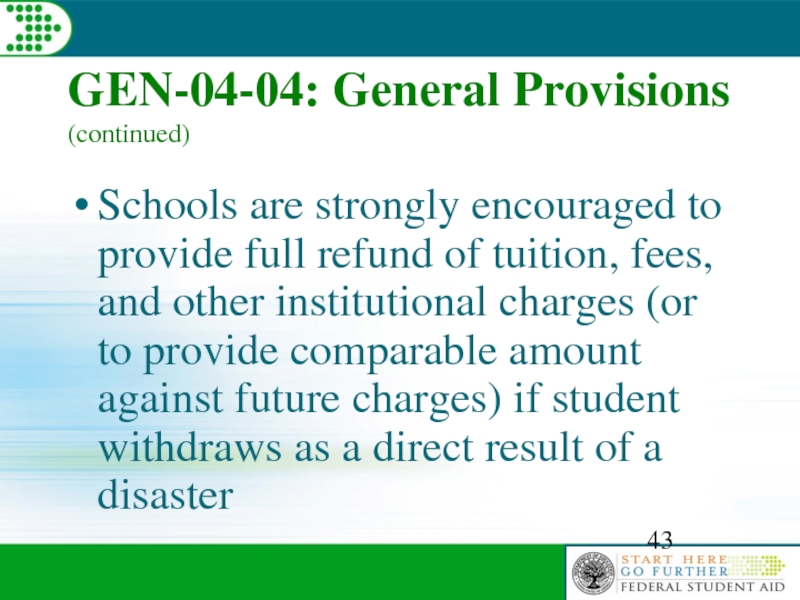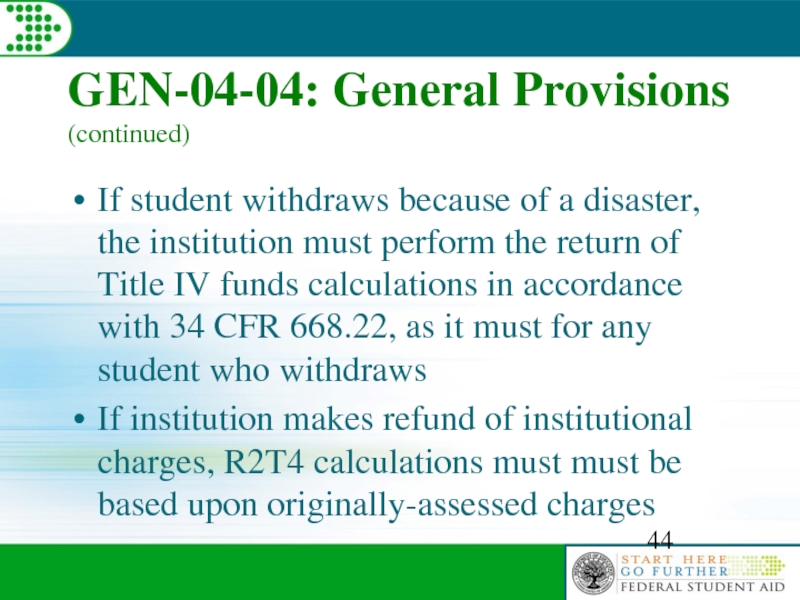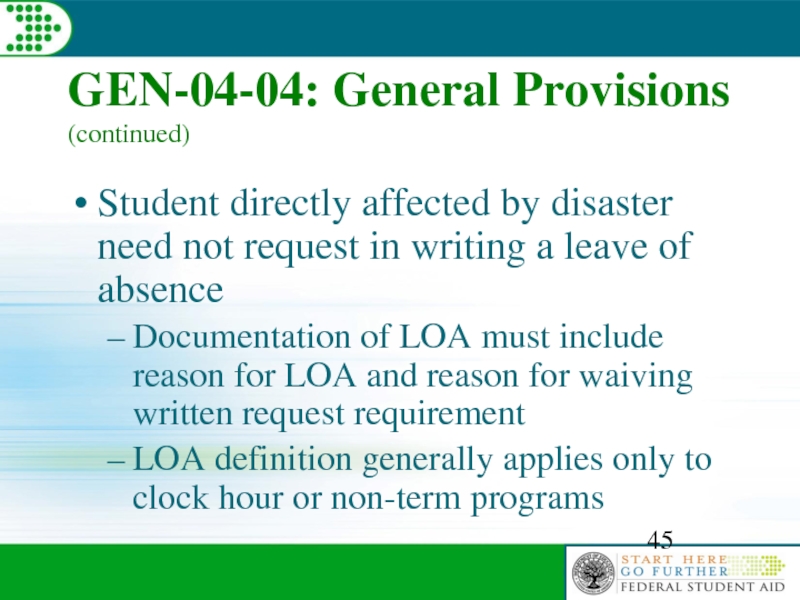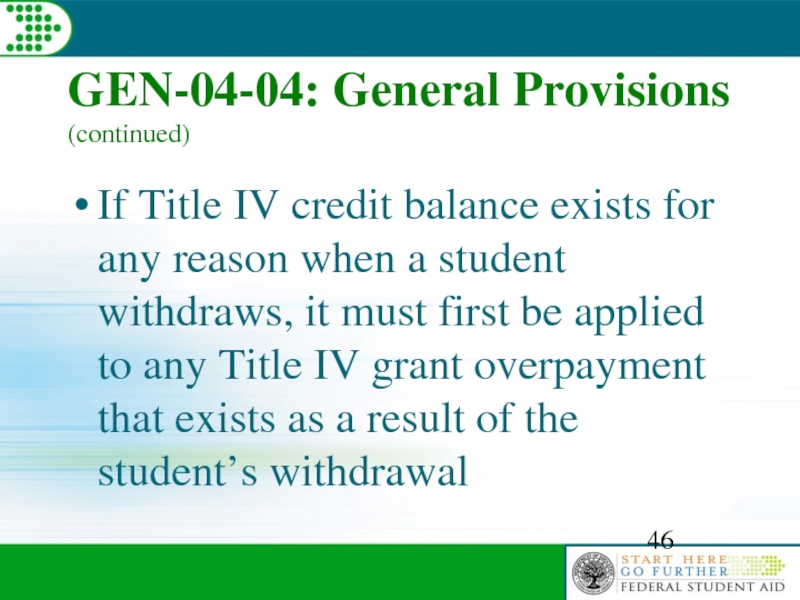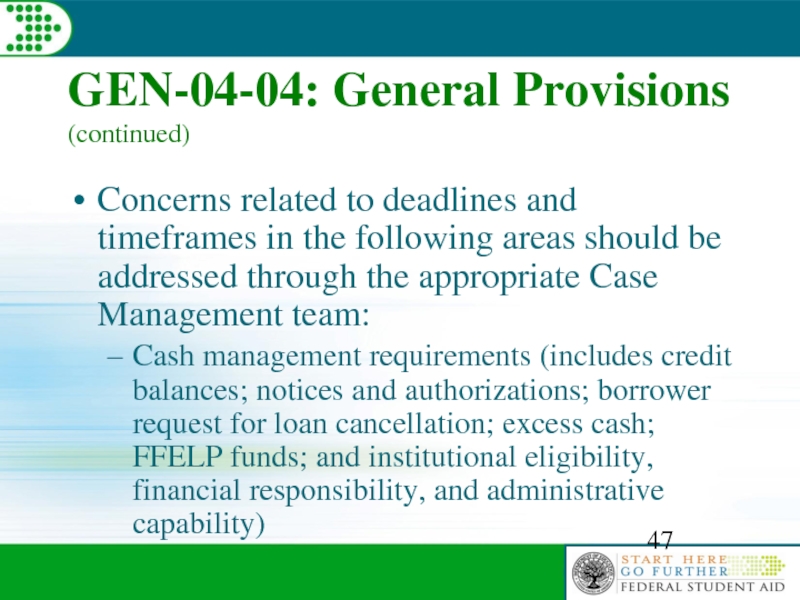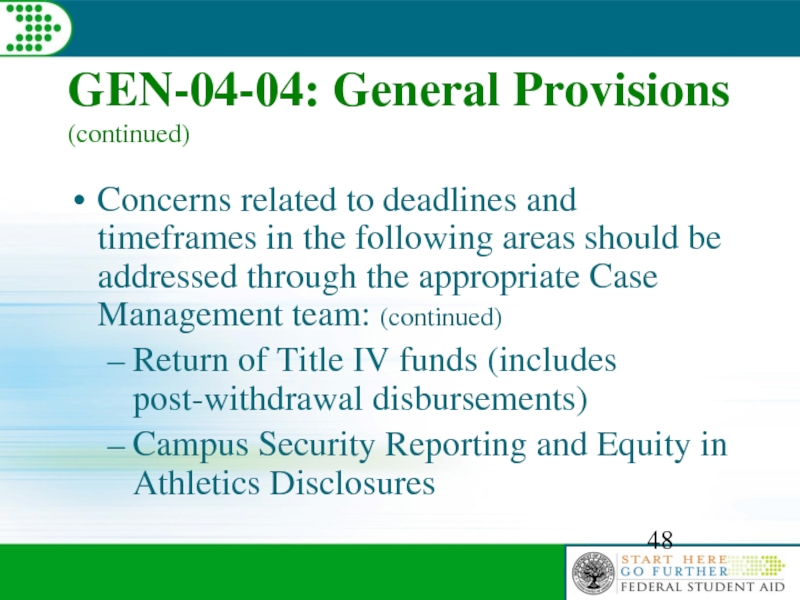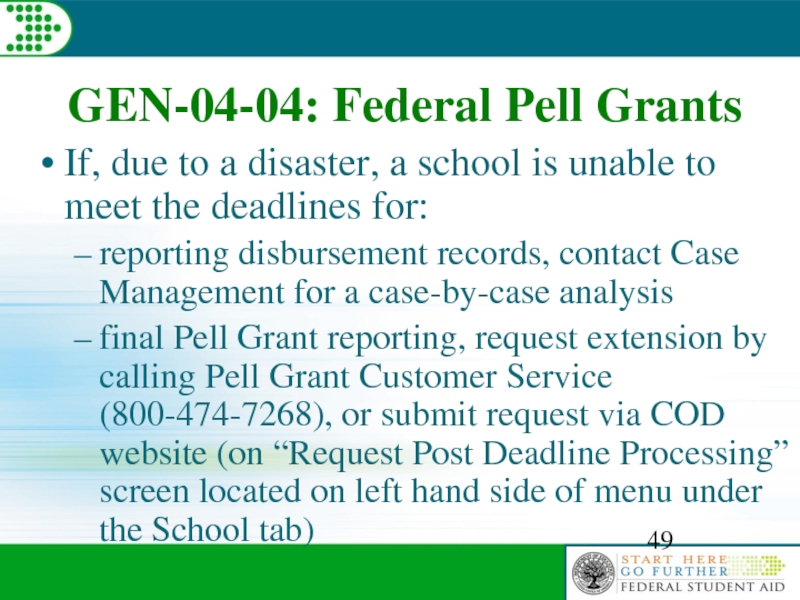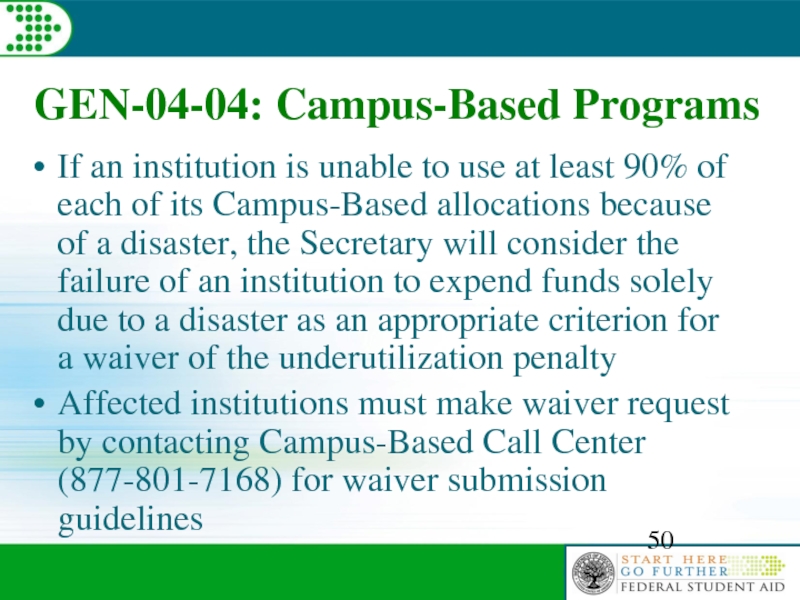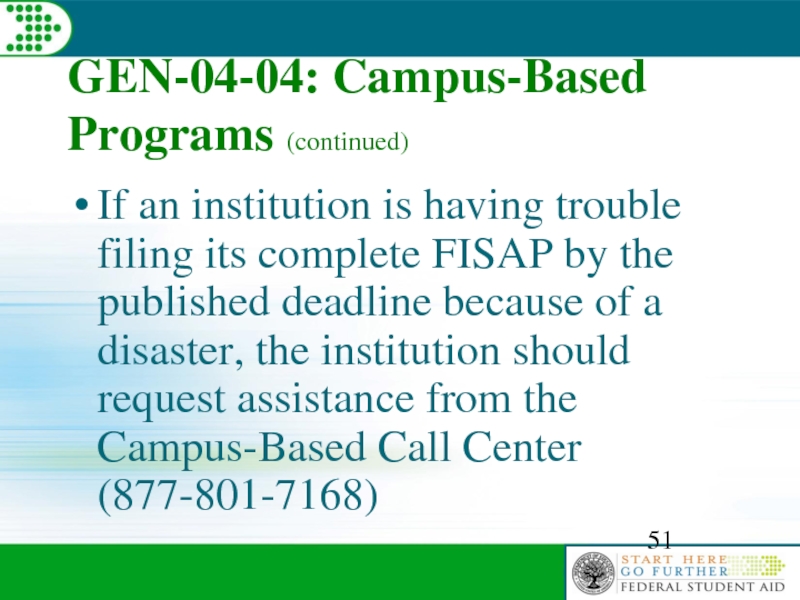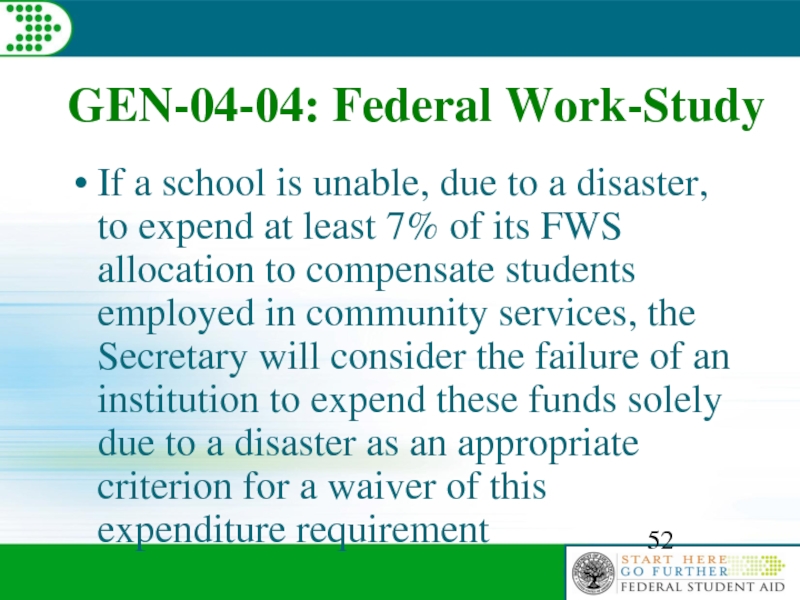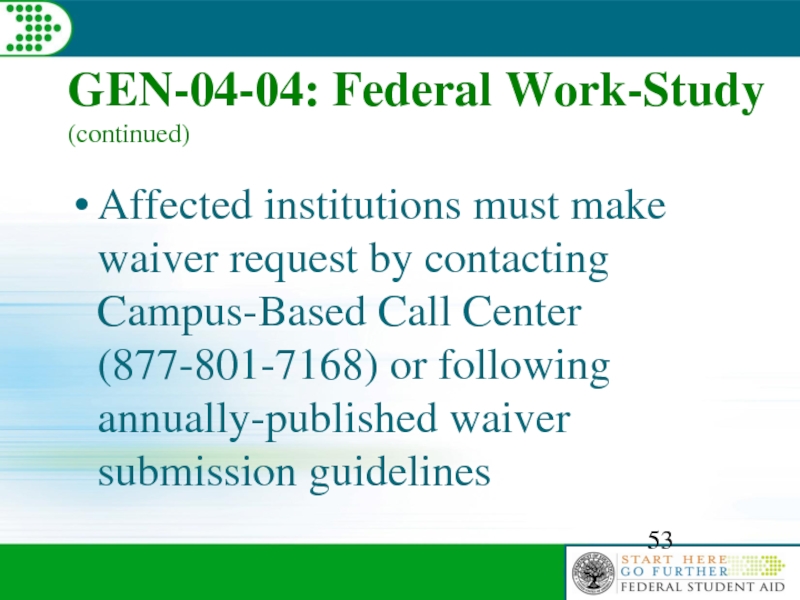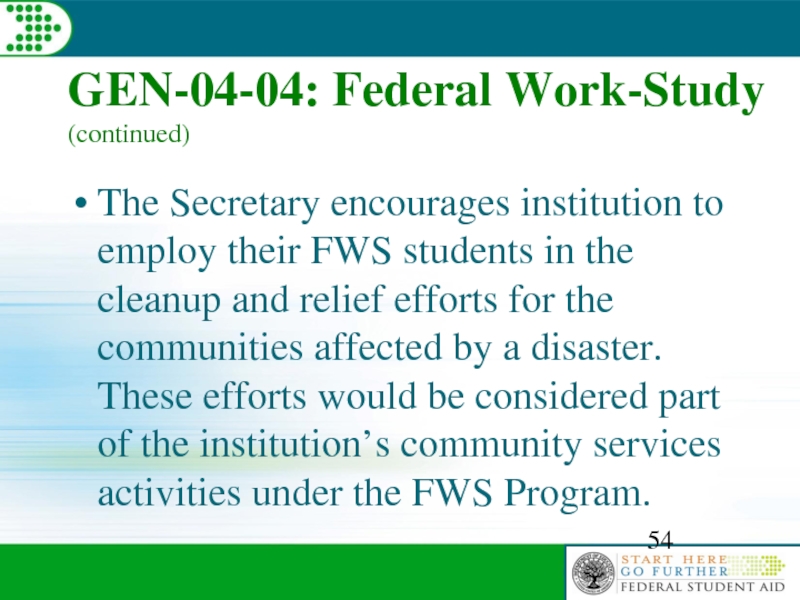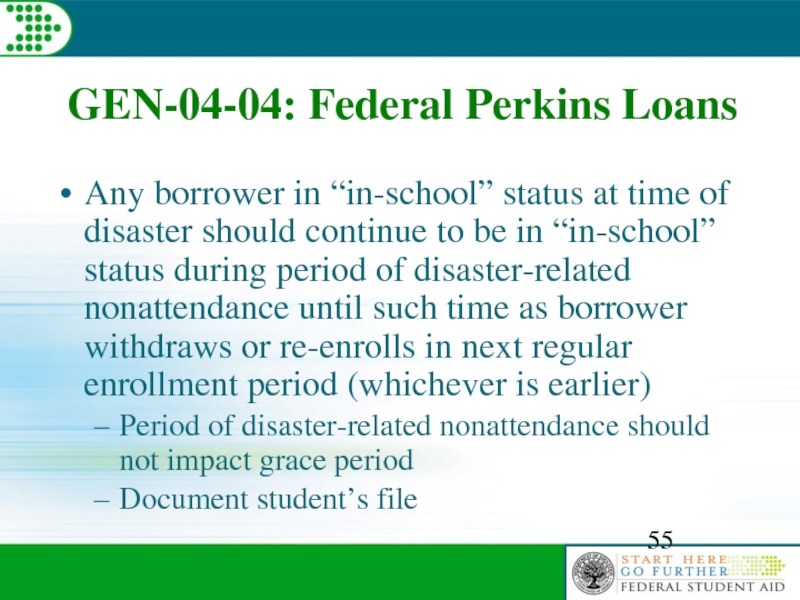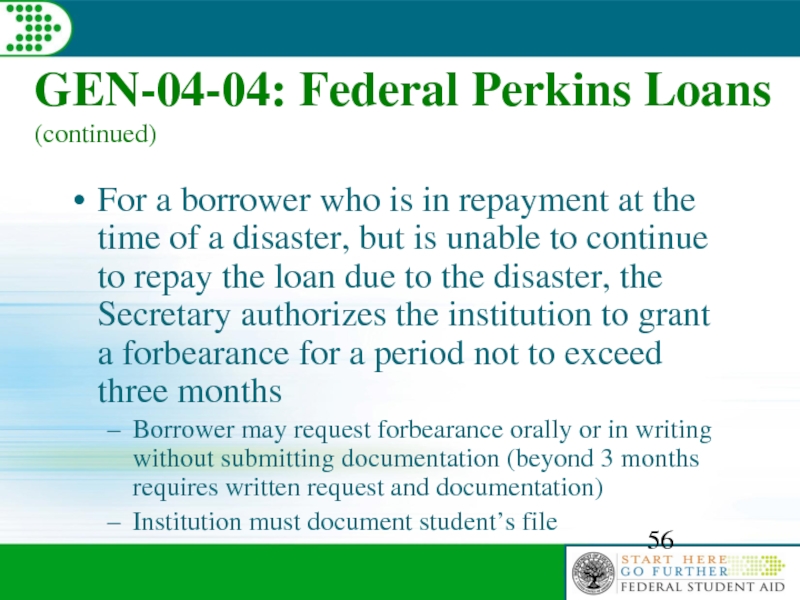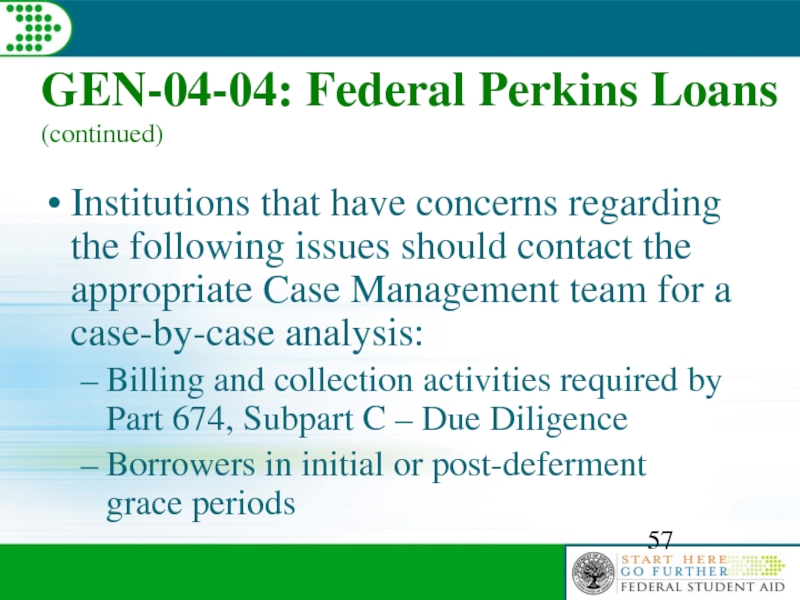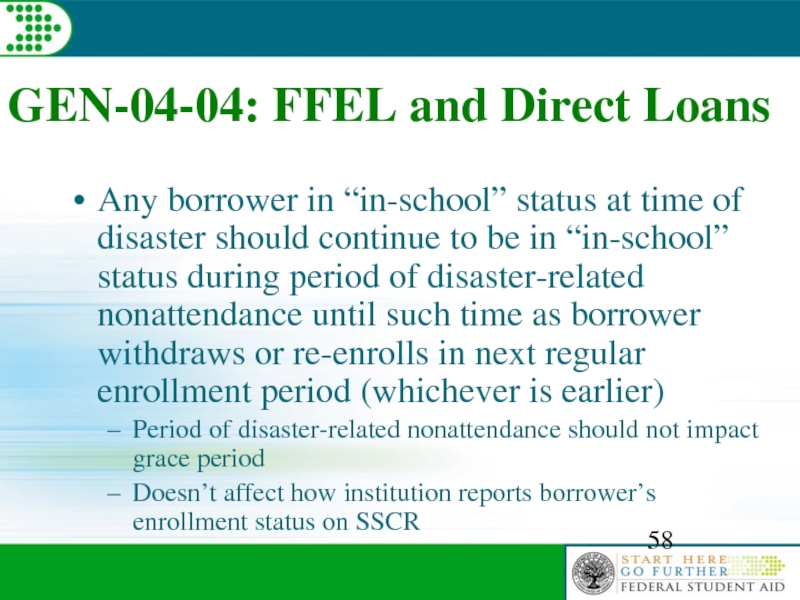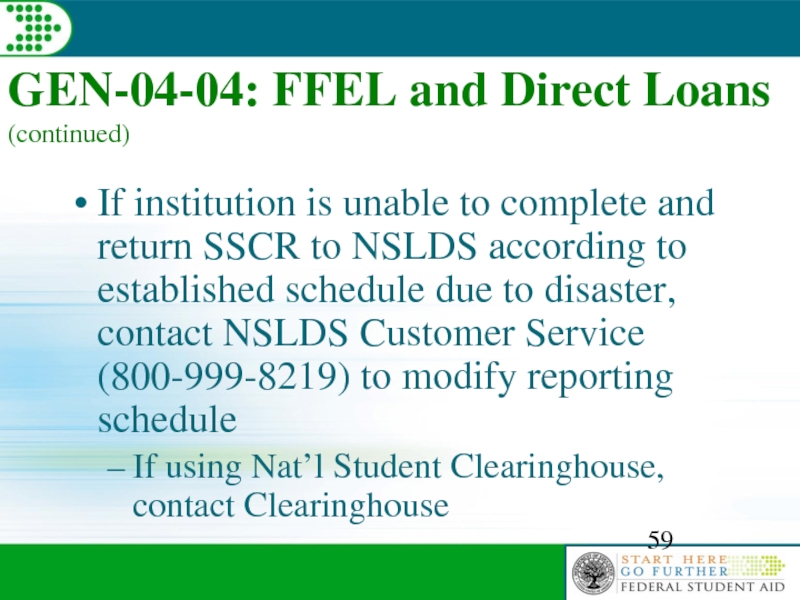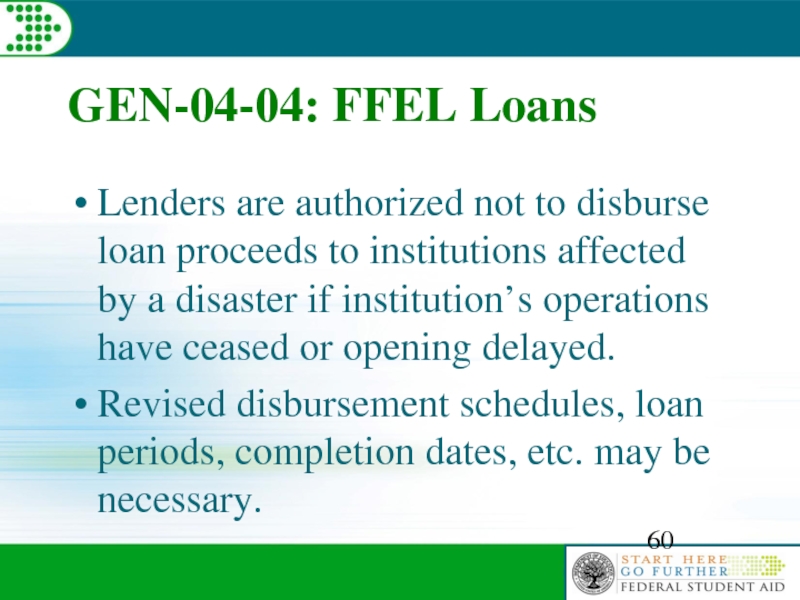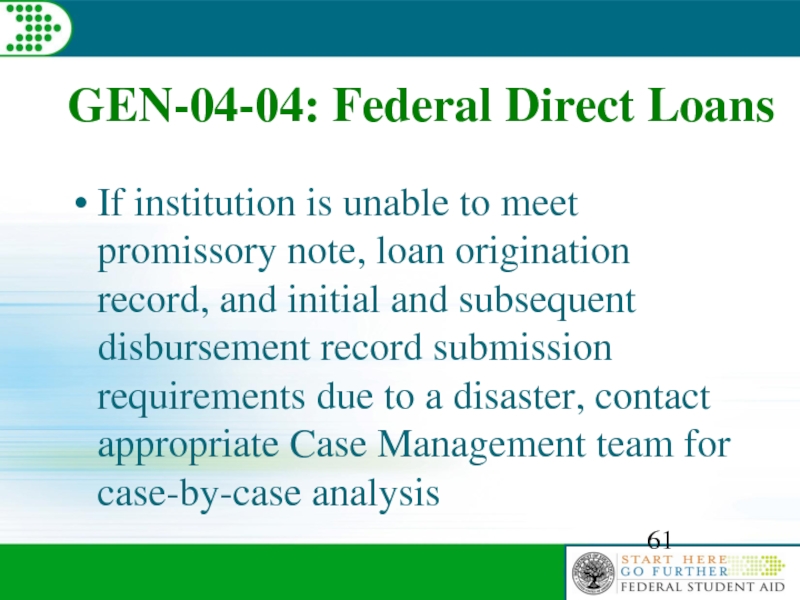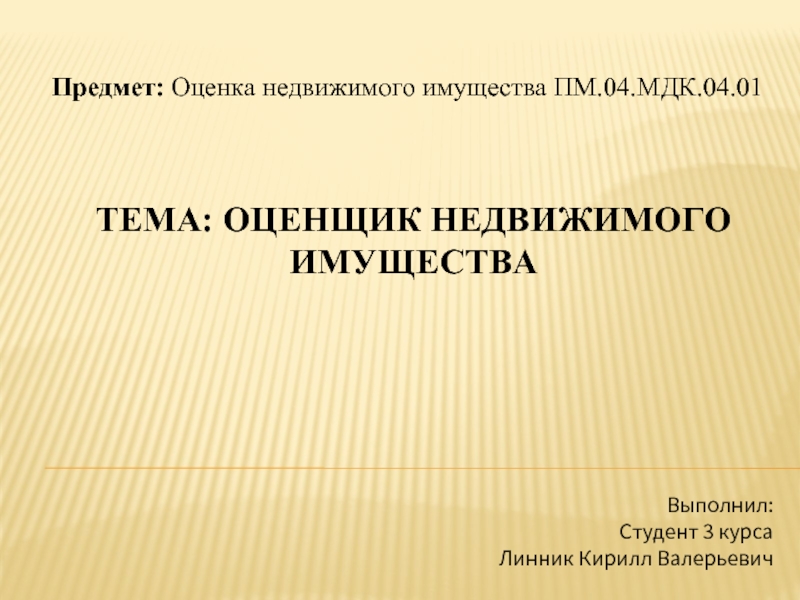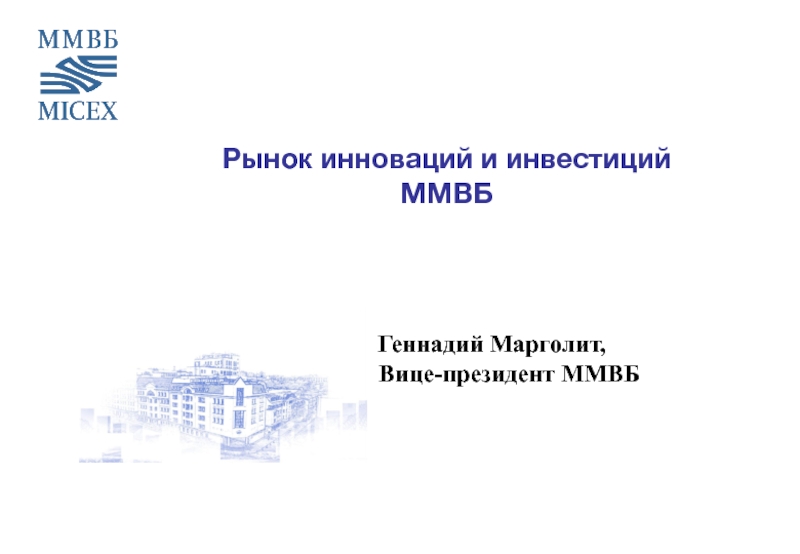- Главная
- Разное
- Дизайн
- Бизнес и предпринимательство
- Аналитика
- Образование
- Развлечения
- Красота и здоровье
- Финансы
- Государство
- Путешествия
- Спорт
- Недвижимость
- Армия
- Графика
- Культурология
- Еда и кулинария
- Лингвистика
- Английский язык
- Астрономия
- Алгебра
- Биология
- География
- Детские презентации
- Информатика
- История
- Литература
- Маркетинг
- Математика
- Медицина
- Менеджмент
- Музыка
- МХК
- Немецкий язык
- ОБЖ
- Обществознание
- Окружающий мир
- Педагогика
- Русский язык
- Технология
- Физика
- Философия
- Химия
- Шаблоны, картинки для презентаций
- Экология
- Экономика
- Юриспруденция
Contingency Planning: How to Keep Operating During Any Type of Disaster презентация
Содержание
- 1. Contingency Planning: How to Keep Operating During Any Type of Disaster
- 2. Session Overview A Personal Experience Contingency Planning Reference Information General Guidance Dear Colleague Letter GEN-04-04
- 3. A Personal Experience Cathy Brown University of West Florida
- 4. What’s The Worst That Could Happen? Earth Wind Fire Water Humans
- 5. "If you fail to plan, then you
- 6. "If you fail to plan, then you
- 7. “Not Just Back, Better” Taking care of
- 8. What We Learned Know the likely hazards
- 9. Contingency Planning Mary Haldane Federal Student Aid
- 10. What Are the Different Types of Emergency
- 11. What Are the Different Types of Emergency
- 12. Why Develop a Contingency Plan? Ensure
- 13. Why Develop a Contingency Plan? (continued) Minimize
- 14. How to Develop a Contingency Plan –
- 15. How to Develop a Contingency Plan –
- 16. Important Components of a Contingency Plan
- 17. Important Components of a Contingency Plan (continued) Training Testing Alternate Facilities Location Equipment
- 18. Important Components of a Contingency Plan (continued)
- 19. Important Components of a Contingency Plan (continued)
- 20. Important Components of a Contingency Plan (continued)
- 21. Important Components of a Contingency Plan (continued) Vital Records Location Media Access
- 22. Important Components of a Contingency Plan Data
- 23. Lessons Learned – Contingency Planning People Are
- 24. Lessons Learned – Contingency Planning (continued) KISS
- 25. Lessons Learned - Occupancy Emergency Planning
- 26. Reference Information / General Guidance Anthony Jones Office of Postsecondary Education
- 27. Reference Information Dear Colleague Letters, Federal Registers,
- 28. Reference Information (continued) Hurricanes Katrina & Rita:
- 29. Reference Information (continued) Federal Student Aid Handbook Regulations Professional Judgment FFEL and Direct Loans
- 30. Regulatory Guidance Regulatory guidance is in 34
- 31. Regulatory Guidance (continued) Similar treatment for Federal
- 32. General Guidance for Disasters Unless otherwise noted,
- 33. General Guidance for Disasters (continued) Guidance applies
- 34. General Guidance for Disasters (continued) Guidance also
- 35. General Guidance for Disasters (continued) When Federally-declared
- 36. General Guidance for Disasters (continued) Always document
- 37. GEN-04-04: General Provisions If school is unable
- 38. GEN-04-04: General Provisions (continued) If, as a
- 39. GEN-04-04: General Provisions (continued) Disaster-related assistance received
- 40. GEN-04-04: General Provisions (continued) FAAs are encouraged
- 41. GEN-04-04: General Provisions (continued) If student fails
- 42. GEN-04-04: General Provisions (continued) For those applicants
- 43. GEN-04-04: General Provisions (continued) Schools are strongly
- 44. GEN-04-04: General Provisions (continued) If student withdraws
- 45. GEN-04-04: General Provisions (continued) Student directly affected
- 46. GEN-04-04: General Provisions (continued) If Title IV
- 47. GEN-04-04: General Provisions (continued) Concerns related to
- 48. GEN-04-04: General Provisions (continued) Concerns related to
- 49. GEN-04-04: Federal Pell Grants If, due to
- 50. GEN-04-04: Campus-Based Programs If an institution is
- 51. GEN-04-04: Campus-Based Programs (continued) If an institution
- 52. GEN-04-04: Federal Work-Study If a school is
- 53. GEN-04-04: Federal Work-Study (continued) Affected institutions must
- 54. GEN-04-04: Federal Work-Study (continued) The Secretary encourages
- 55. GEN-04-04: Federal Perkins Loans Any borrower in
- 56. GEN-04-04: Federal Perkins Loans (continued) For a
- 57. GEN-04-04: Federal Perkins Loans (continued) Institutions that
- 58. GEN-04-04: FFEL and Direct Loans Any borrower
- 59. GEN-04-04: FFEL and Direct Loans (continued) If
- 60. GEN-04-04: FFEL Loans Lenders are authorized not
- 61. GEN-04-04: Federal Direct Loans If institution is
- 62. Contact Information Your feedback and comments are
Слайд 2Session Overview
A Personal Experience
Contingency Planning
Reference Information
General Guidance
Dear Colleague Letter GEN-04-04
Слайд 5"If you fail to plan, then you plan to fail"
Evacuation
When to close, when to evacuate?
Who’s in charge?
Who stays, who goes?
Where to go and how?
When to return?
What can you take in 15 minutes and how?
Слайд 6"If you fail to plan, then you plan to fail“ (continued)
Security/Safety
Public
Data
Слайд 7“Not Just Back, Better”
Taking care of faculty and staff
Immediate relief for
Putting the pieces back together; recovering information
It will be better
Слайд 8What We Learned
Know the likely hazards you face and plan accordingly
Back
Identify building and floor wardens
Have personal emergency kits at the ready
Training, training, training
People care. Let them help.
Слайд 10What Are the Different Types of Emergency Plans
Occupant Emergency Plan
Ensures Safety
Evacuation
Shelter in Place (SIP)
Слайд 11What Are the Different Types of Emergency Plans (continued)
Disaster Recovery Plan
Ensures
Ensures the Continuation of Essential Functions Across a Wide Range of Potential Emergencies to Provide For:
Business Process Continuity
Organizational Continuity
IT Continuity
Слайд 12Why Develop a Contingency Plan?
Ensure the Safety of Students, Faculty,
Prepare Staff and Students for Any Emergency
Ensure the Continuation of Essential Functions During an Emergency
Слайд 13Why Develop a Contingency Plan? (continued)
Minimize Damage and Losses Resulting From
Facilitate Decision Making During an Emergency
Achieve a Timely and Orderly Recovery From a Disruption of Services Caused by an Emergency
Слайд 14How to Develop a Contingency Plan – A Five Point Plan
Contingency Plan Development Team
Resources
Roles and Responsibilities
Business Impact Analysis
Requirements, Processes, and Interdependencies for Contingency Planning
Слайд 15How to Develop a Contingency Plan – A Five Point Plan
Continuity Strategies
Cost, System Sensitivity, and Recovery Time Objectives
Plan testing, training, and exercise
Plan maintenance
Слайд 16Important Components of a Contingency Plan
Response Team
Roles:
Senior Management Team
Damage Assessment
Continuity Activities - Lead and Team Members
Resumption Activities - Lead and Team Members
Слайд 17Important Components of a Contingency Plan (continued)
Training
Testing
Alternate Facilities
Location
Equipment
Слайд 18Important Components of a Contingency Plan (continued)
Notification/Activation Procedures
Notification of Senior Management
Performing Damage Assessment Procedures
Essential Functions, Their Priority Order for Recovery, and When They Need to Be Functioning
Слайд 19Important Components of a Contingency Plan (continued)
Continuity Activities
Activities to Perform to
Resumption of Normal Activities Procedures
Activities to Return the Institution to Normal Operating Procedures and Processing Capabilities
Слайд 20Important Components of a Contingency Plan (continued)
Communication Plan
Internal Procedures and Templates
External
Accounting for Faculty, Staff, and Students Procedures
Contact information for faculty, staff, students/parents, and internal and external dependencies
Слайд 22Important Components of a Contingency Plan
Data Backup and Off Site Storage
Awareness
Flyaway Kits
Cell Phones and Chargers
BlackBerries and Chargers
Identification
Contingency Plan
Occupant Emergency Plan
Disaster Recovery Plan
Vital Records
Слайд 23Lessons Learned – Contingency Planning
People Are the First Priority
Practice – Practice
Practice Real Scenarios
Assume No Essential Services
Make Common Sense Decisions
Be Prepared to Make Decisions Outside of “Rules”
Involve Local Authorities
Слайд 24Lessons Learned – Contingency Planning (continued)
KISS Principle
A Contingency Plan Is a
Keep Plan Current
Confirm Communications Are Received
Backup
Essential Data
Response Team
Phone Tree Callers
Pre-Position Vital Records at Alternate Site
Слайд 25Lessons Learned - Occupancy Emergency Planning
Establish Building Captains
Establish Floor Captains
Emergency Supplies
Слайд 27Reference Information
Dear Colleague Letters, Federal Registers, and Electronic Announcements
General guidance for
Слайд 28Reference Information (continued)
Hurricanes Katrina & Rita:
Electronic Announcements (posted on IFAP beginning
Federal Register (09/09/05) announcing deadline extensions
IFAP links to additional information
09/11 Terrorist Attacks: GEN-01-11, GEN-01-12, GEN-01-13, all posted on IFAP 09/2001
Disaster Letter 99-28, posted on IFAP on August 5, 1999
Слайд 29Reference Information (continued)
Federal Student Aid Handbook
Regulations
Professional Judgment
FFEL and Direct Loans
Слайд 30Regulatory Guidance
Regulatory guidance is in 34 CFR 682.211(f)(11) -- allows loan
Natural disaster;
Local or national emergency (as declared by appropriate government agency); or
Military mobilization
Слайд 31Regulatory Guidance (continued)
Similar treatment for Federal Direct Loans
DCL GEN-04-04 (FP-04-03) clarifies
Слайд 32General Guidance for Disasters
Unless otherwise noted, guidance applies to Federally-declared disaster
FEMA website is official source (www.fema.gov)
Слайд 33General Guidance for Disasters (continued)
Guidance applies to all Title IV borrowers,
Residing;
Employed; or
Attending eligible postsecondary institution, in Federally-declared disaster area.
Слайд 34General Guidance for Disasters (continued)
Guidance also applies to institutions, lenders, and
Additional guidance may be issued that supplements or supercedes GEN-04-04 (usually through posts to IFAP)
Слайд 35General Guidance for Disasters (continued)
When Federally-declared disaster has impacted a school’s
In many cases in which ED could not provide standard or across-the-board relief, we direct the school to contact their Case Management team for a case-by-case analysis of the school’s situation.
Слайд 36General Guidance for Disasters (continued)
Always document when deviating from otherwise required
Must document when invoking GEN-04-04 guidance
Note that specific future statutory authority may change or enhance the guidance in GEN-04-04
For example, Hurricanes Katrina and Rita special exceptions and allocations, and R2T4 student grant overpayments
ED will most likely issue some form of guidance or statement when this authority is granted
Слайд 37GEN-04-04: General Provisions
If school is unable to continue providing student’s eligible
See 34 CFR 668.5 for applicable regulations
Attempt to reconstruct any records lost, destroyed, or rendered illegible due to a disaster, but if unable to do so, document in the student’s file that records were lost/destroyed/damaged due to disaster
Слайд 38GEN-04-04: General Provisions (continued)
If, as a direct result of a disaster,
Case Management will determine, on a case-by-case basis, continued program eligibility and students’ continued eligibility for Title IV assistance
Слайд 39GEN-04-04: General Provisions (continued)
Disaster-related assistance received by from the Federal or
Слайд 40GEN-04-04: General Provisions (continued)
FAAs are encouraged to use their professional judgment
Must still make adjustments on a case-by-case basis and clearly document the student’s file with the reasons
Слайд 41GEN-04-04: General Provisions (continued)
If student fails to meet satisfactory academic progress
must document student’s file that student’s failure to maintain SAP was due to disaster
Слайд 42GEN-04-04: General Provisions (continued)
For those applicants selected for verification whose records
Must document when verification is not performed for this reason
When reporting Federal Pell Grant disbursement, use verification status code “S”
Слайд 43GEN-04-04: General Provisions (continued)
Schools are strongly encouraged to provide full refund
Слайд 44GEN-04-04: General Provisions (continued)
If student withdraws because of a disaster, the
If institution makes refund of institutional charges, R2T4 calculations must must be based upon originally-assessed charges
Слайд 45GEN-04-04: General Provisions (continued)
Student directly affected by disaster need not request
Documentation of LOA must include reason for LOA and reason for waiving written request requirement
LOA definition generally applies only to clock hour or non-term programs
Слайд 46GEN-04-04: General Provisions (continued)
If Title IV credit balance exists for any
Слайд 47GEN-04-04: General Provisions (continued)
Concerns related to deadlines and timeframes in the
Cash management requirements (includes credit balances; notices and authorizations; borrower request for loan cancellation; excess cash; FFELP funds; and institutional eligibility, financial responsibility, and administrative capability)
Слайд 48GEN-04-04: General Provisions (continued)
Concerns related to deadlines and timeframes in the
Return of Title IV funds (includes post-withdrawal disbursements)
Campus Security Reporting and Equity in Athletics Disclosures
Слайд 49GEN-04-04: Federal Pell Grants
If, due to a disaster, a school is
reporting disbursement records, contact Case Management for a case-by-case analysis
final Pell Grant reporting, request extension by calling Pell Grant Customer Service (800-474-7268), or submit request via COD website (on “Request Post Deadline Processing” screen located on left hand side of menu under the School tab)
Слайд 50GEN-04-04: Campus-Based Programs
If an institution is unable to use at least
Affected institutions must make waiver request by contacting Campus-Based Call Center (877-801-7168) for waiver submission guidelines
Слайд 51GEN-04-04: Campus-Based Programs (continued)
If an institution is having trouble filing its
Слайд 52GEN-04-04: Federal Work-Study
If a school is unable, due to a disaster,
Слайд 53GEN-04-04: Federal Work-Study (continued)
Affected institutions must make waiver request by contacting
Слайд 54GEN-04-04: Federal Work-Study (continued)
The Secretary encourages institution to employ their FWS
Слайд 55GEN-04-04: Federal Perkins Loans
Any borrower in “in-school” status at time of
Period of disaster-related nonattendance should not impact grace period
Document student’s file
Слайд 56GEN-04-04: Federal Perkins Loans (continued)
For a borrower who is in repayment
Borrower may request forbearance orally or in writing without submitting documentation (beyond 3 months requires written request and documentation)
Institution must document student’s file
Слайд 57GEN-04-04: Federal Perkins Loans (continued)
Institutions that have concerns regarding the following
Billing and collection activities required by Part 674, Subpart C – Due Diligence
Borrowers in initial or post-deferment grace periods
Слайд 58GEN-04-04: FFEL and Direct Loans
Any borrower in “in-school” status at time
Period of disaster-related nonattendance should not impact grace period
Doesn’t affect how institution reports borrower’s enrollment status on SSCR
Слайд 59GEN-04-04: FFEL and Direct Loans (continued)
If institution is unable to complete
If using Nat’l Student Clearinghouse, contact Clearinghouse
Слайд 60GEN-04-04: FFEL Loans
Lenders are authorized not to disburse loan proceeds to
Revised disbursement schedules, loan periods, completion dates, etc. may be necessary.
